Fortran中的数组与动态数组
数组与动态数组示例
program array_exam
implicit none
integer, parameter :: n = 5
integer :: i
integer :: static_array(n) = [1,2,3,4,5]
integer, allocatable :: dynamic_array(:)
allocate(dynamic_array(n))
dynamic_array = [(i * 2, i = 1, n)]
print *, "Static Array:"
do i = 1, n
print *, static_array(i)
end do
print *, "Dynamic Array:"
do i = 1, n
print *, dynamic_array(i)
end do
deallocate(dynamic_array)
write(*,*) "Program over!"
read(*,*)
end program array_exam
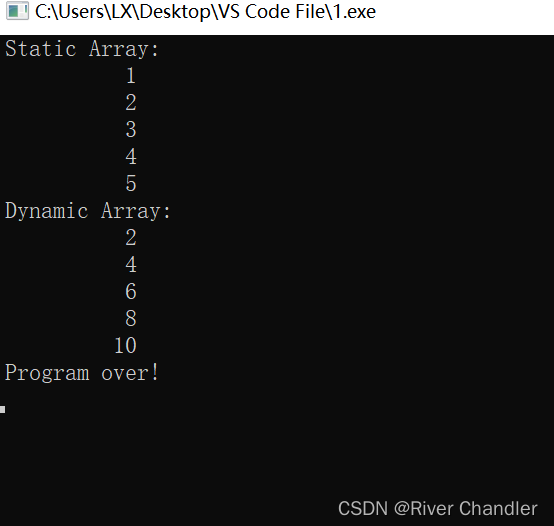
动态数组的优势
处理不定长数据
- 利用动态数组从不定长文件中读取数据
- 事实上,在实际工作中,我们往往需要注意到一个问题
- 你怎么可能不知道要处理的数据的长度呢?
- 当然,傻瓜x方可能不懂规范
- 也有可能有二傻子在文件中添加没有意义的注释啥的
- 只需要将文件大小除一下字节长度即可
- 你怎么可能不知道要处理的数据的长度呢?
program data_storage
implicit none
integer :: n, i
real, allocatable :: data(:)
real, allocatable :: newdata(:)
open(unit=10, file='data.txt', status='old', action='read')
n = 1
allocate(data(1))
do
read(10, *, iostat=i) data(n)
if ((i /= 0) .and. (i /= -1)) then
write(*,*)"here is:",n
write(*,*)"fail because iostat is:",i
exit
end if
if (i /= -1) then
n = n + 1
allocate(newdata(n),stat=i)
newdata(1:n-1) = data(1:n-1)
deallocate(data)
allocate(data(n), stat=i)
data(1:n-1) = newdata(1:n-1)
deallocate(newdata)
else
write(*,*)"read over!"
n = n - 1
allocate(newdata(n),stat=i)
newdata(1:n) = data(1:n)
deallocate(data)
allocate(data(n), stat=i)
data(1:n) = newdata(1:n)
deallocate(newdata)
exit
end if
end do
close(10)
print *, "Array size:", n
print *, "Array elements:"
do i = 1, n
print *, data(i)
end do
deallocate(data)
write(*,*)"press any key to exit !"
read(*,*)
end program data_storage
- fortran90 中有一个小问题,他必须读了之后才能知道具体有没有达到文章的末尾,所以会有一串if i == -1 的问题
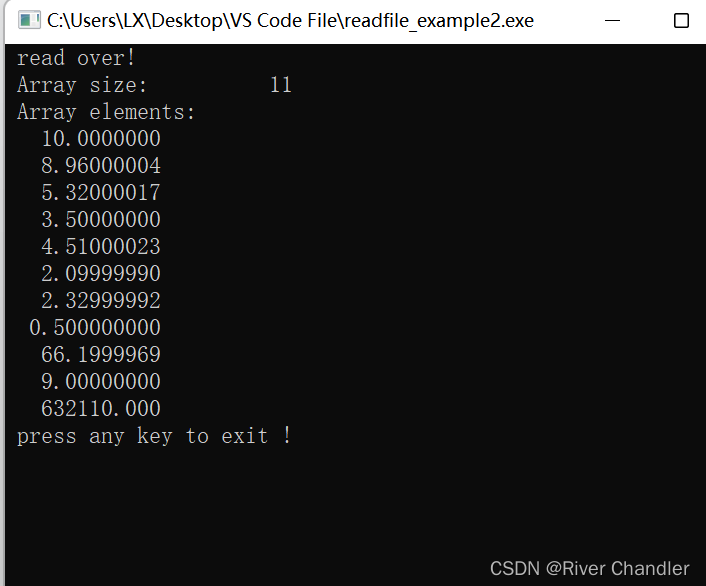
- 数据文件结构:
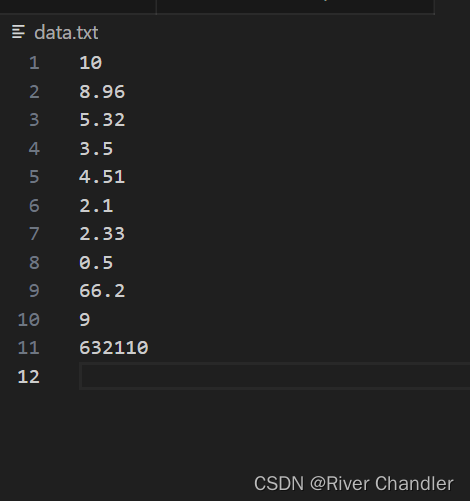
数组与多维数组
- 数组的声明
- 类型说明符 数组名([维数下界(默认为1):]维数上界)
- 类型说明符,维度([维数下界(默认为1):]维数上界):: 数组名
- 数组的引用
- 下标为6的元素:a(6)
- 数组名(【起始下标】:【终止下标】【:步长】):a(1:10:3)
- 数组的赋值语句
- a(i) = i
- a(5) = (/1,2,3,4,5/)
- 限制 fortran90 以后
- data 赋值方法
数组中元素的存储顺序与data赋值方法
- [m,n]:n行m列
- Fortran 中的存储顺序十分的甚至可以说九分的复杂,他是基于一种神秘的考虑逻辑的,简单的说
- 我们在数字电路中学习过最小项的概念,
- fortran的存储顺序是与最小项这一个概念类似的。
- 如 A0 A1 A2 A3...
- 对应的是 (A0,A1,A2,A3) 的数组
- fortran的存储顺序是与最小项这一个概念类似的。
- 我们在数字电路中学习过最小项的概念,
data 赋值方法
- 普通赋值
- 这里的 and 符号 表示分行写代码
program data_example
implicit none
real :: a(5)
integer i
data a / 1.0,&
2.0,&
3.0,&
4.0,&
5.0 /
write(*,*) "Array:"
do i = 1, 5
write(*,*) a(i)
end do
read(*,*)
end program data_example
- 多维数组

program data_example
implicit none
real :: b(2,3)
integer i,j
data b /1.0, 2.0, 3.0 ,4.0, 5.0, 6.0 /
write(*,*) "Array :"
do i = 1,2
do j = 1,3
write(*,*) b(i,j)
end do
end do
read(*,*)
end program data_example
数组函数
maxval() and minval()

program function_example
implicit none
integer i
real :: f(3, 4)
real :: max_value = 0
real :: min_value = 0
f = reshape([(i, i=1, size(f))], [3,4])
write(*,*)"array f:"
write(*,*)f
max_value = maxval(f(:,2))
print *, "Max value of array f:", max_value
min_value = minval(f(3,:))
print *, "Min value of array f:", min_value
write(*,*)"press any key to exit"
read(*,*)
end program function_example
maxloc() and minloc()
- 注意,这两个函数返回的是一个只包含一个元素的一维数组
program array
implicit none
real,dimension(1:6) :: a = (/ 21.0, 12.0,33.0, 24.0,15.0, 16.0/)
real,dimension(2,3) :: b
integer max_a(1)
integer min_a(1)
b = reshape(a,[2,3])
write(*,*) "max of a"
max_a = maxloc(a)
write(*,*) max_a
write(*,*) "min of a"
min_a = minloc(a)
write(*,*) min_a
read(*,*)
end program array

sum() and product()
- 求和和求乘积
program sum_function_example
implicit none
integer :: h(4)
real :: total_sum
real :: total_pro
h = [3, 6, 9, 12]
total_sum = sum(h)
total_pro = product(h)
write(*,*)"Total sum of array h:", total_sum
write(*,*)"Total pro of array h:", total_pro
write(*,*) "press any key to exit"
read(*,*)
end program sum_function_example

count()
program count_function_example
implicit none
integer :: k(6)
integer :: num
k = [1, 10, 1, -10, 1, 1]
num = count(k==1)
print *, "Number of 1 in array:", num
num = count(k.gt.1)
print *, "Number bigger than 1 in array:", num
num = count(k.le.1)
print *, "Number smaller than or equal 1 in array:", num
read(*,*)
end program count_function_example
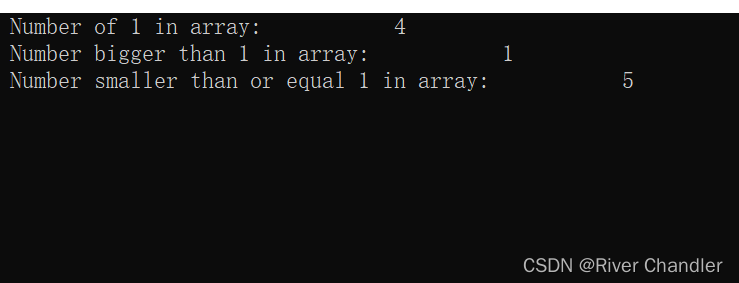
all() and any()
program all_function_example
implicit none
logical :: l(3)
logical :: resultl
logical :: m(4)
logical :: resultm
l = [.true., .false., .true.]
resultl = all(l)
write(*,*) "All elements in array are true:", resultl
m = [.false., .true., .false., .false.]
resultm = any(m)
write(*,*) "At least one element in array is true:", resultm
read(*,*)
end program all_function_example

transpose(array)
- 矩阵转置
program function_example
implicit none
integer i,j
integer :: n(2,3)
integer :: transposed(3,2)
n = reshape([1,2,3,4,5,6],[2,3])
transposed = transpose(n)
print *, "Original matrix:"
do i = 1,size(n(:,1))
do j = 1,size(n(1,:))
print *, n(i,j)
end do
end do
print *, "Transposed matrix:"
do i = 1,size(transposed(:,1))
do j = 1,size(transposed(1,:))
print *, transposed(i,j)
end do
end do
read(*,*)
end program function_example
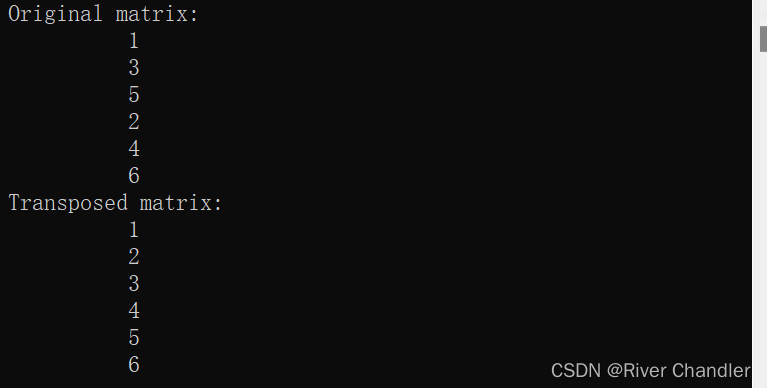
shape(array)
program function_example
implicit none
integer :: a(3,4,5)
integer :: dimension(3)
dimension = shape(a)
write(*,*) "Array dimension:", dimension
read(*,*)
end program function_example

size()
- 所有维度上的元素总数
program function_example
implicit none
real :: b(1,2,3)
integer :: total_size,second_dimension_size
total_size = size(b)
second_dimension_size = size(b, dim=2)
write(*,*) "Total size of array b:", total_size
write(*,*) "Size of second dimension:", second_dimension_size
read(*,*)
end program function_example

lbound() and ubound()
- 返回给定数组在指定维度上的最低(高)索引
program function_example
implicit none
real :: c(-4:5,10)
integer :: starting_index, ending_index
starting_index = lbound(c,dim=1)
ending_index = ubound(c, dim=2)
print *, "Starting index of first dimension:", starting_index
print *, "Ending index of second dimension:", ending_index
read(*,*)
end program function_example

reshape(source_array, shape)
-
一定要记得提前分配内存,任何时候都要记得这件事情
-
具体操作参见上面的操作代码,有相关reshape函数的使用
-
流传很广的一些计算机笑话
- Why programmers always mix up Halloween and Christmas?
- Because Oct 31 == Dec 25!
- There are 10 types of people in the world: Those who understand binary, those who don't
Good Luck!
To my best friend for my rest life.






















 8682
8682

 被折叠的 条评论
为什么被折叠?
被折叠的 条评论
为什么被折叠?










